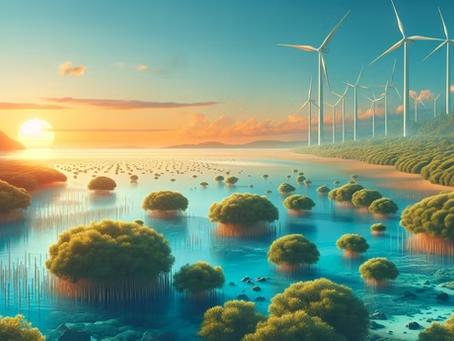The Promise of Blue Carbon: Harnessing Coastal Ecosystems for Climate Mitigation
Blue carbon ecosystems—mangroves, seagrasses, and salt marshes—are nature’s frontline allies in the fight against climate change. These coastal habitats capture and store carbon at rates far exceeding terrestrial forests, making them essential for global climate mitigation. Yet, despite their immense value, they remain vulnerable to human activity, environmental degradation, and the accelerating impacts of climate change.
Key Takeaways
- Blue carbon refers to carbon captured by coastal ecosystems such as mangroves, seagrasses, and salt marshes.
- These ecosystems sequester carbon more efficiently than terrestrial forests but face growing threats.
- Conservation and restoration of blue carbon habitats are vital for achieving climate goals.
- Economic tools like carbon credits can incentivize sustainable blue carbon management.
- Community knowledge, innovation, and international cooperation are central to long-term success.
What is Blue Carbon?
Blue carbon describes the carbon stored by coastal and marine ecosystems. Mangroves with their tangled roots, seagrasses forming lush underwater meadows, and salt marshes in temperate zones all play pivotal roles in capturing carbon. These ecosystems can store up to five times more carbon per unit area than land-based forests, often locking it away in soils and sediments for centuries.
The Science of Carbon Storage
- Sequestration: Plants absorb CO2 through photosynthesis and store it as organic matter.
- Sedimentation: Organic matter settles into seabed soils.
- Burial: Layers of sediment preserve the carbon, preventing its release.
By understanding these processes, scientists emphasize why blue carbon is critical for climate mitigation.
The Guardians of Blue Carbon
Mangroves
Coastal protectors that defend shorelines from erosion, act as nurseries for marine life, and sequester carbon in biomass and soil.
Seagrass Meadows
Underwater prairies that absorb carbon at remarkable rates while supporting biodiversity and stabilizing coastlines.
Salt Marshes
Resilient wetlands that store immense amounts of carbon in dense roots and soils, while buffering storm impacts.
Threats to Blue Carbon Ecosystems
- Rising Seas: Erosion and inundation threaten the survival of coastal habitats.
- Human Activity: Pollution, shrimp farming, and development lead to ecosystem loss.
- Climate Change: Warmer waters, acidification, and altered salinity disrupt resilience.
Blue Carbon in Climate Mitigation
Blue vs. Green Carbon
Unlike forests that store carbon mainly in biomass, blue carbon ecosystems lock most of it in soils, ensuring millennia-long storage and greater permanence.
Policy Integration
Incorporating blue carbon into climate action plans, carbon inventories, and restoration programs strengthens global net-zero strategies.
Net-Zero Pathways
Protecting and restoring mangroves, seagrasses, and marshes enhances global capacity to neutralize emissions and adapt to climate change.
Conservation and Restoration
- Success Stories: From Bangladesh’s Sundarbans to Seychelles’ marine protected areas, restoration yields ecological and economic benefits.
- Restoration Techniques: Mangrove planting, seagrass seeding, and tidal marsh restoration rebuild natural carbon sinks.
- Community Knowledge: Indigenous wisdom and local stewardship ensure culturally relevant, resilient conservation approaches.
Economics and Blue Carbon Markets
By monetizing carbon storage through credits and ecosystem service valuation, blue carbon gains recognition as an economic asset. Public-private partnerships, green bonds, and impact investing are opening new pathways for funding conservation.
Policy and International Cooperation
Global agreements like the Paris Accord provide frameworks, but effective outcomes depend on local implementation, NGO advocacy, and integration into Nationally Determined Contributions (NDCs). Aligning global ambitions with local realities ensures meaningful progress.
Innovation and Research
- Remote Sensing: Satellites provide real-time monitoring of coastal ecosystem health.
- Standardized Protocols: Unified metrics enable accurate, comparable carbon accounting worldwide.
- Citizen Science: Communities contribute valuable monitoring data while fostering stewardship.
Challenges and Controversies
- Carbon Offsets: Debates continue on their effectiveness and ethical implications.
- Land Rights: Conflicts over ownership and access complicate conservation projects.
- Ecosystem Complexity: Restoring habitats requires understanding intricate ecological interactions.
The Road Ahead
Sustaining blue carbon requires resilient management, innovative financing, and cross-sector collaboration. By valuing these ecosystems as both ecological and economic assets, humanity can unlock their full potential for climate mitigation. With shared commitment, blue carbon may become one of our strongest natural defenses in the fight against climate change.

